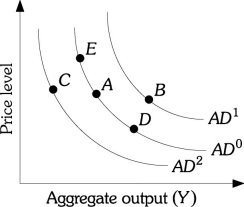Refer to the information provided in Figure 27.1 below to answer the question(s) that follow. Figure 27.1Refer to Figure 27.1. An aggregate demand shift from AD1 to AD0 can be caused by
Figure 27.1Refer to Figure 27.1. An aggregate demand shift from AD1 to AD0 can be caused by
A. an increase in money supply.
B. a decrease in government spending.
C. an increase in the price level.
D. a decrease in the price level.
Answer: B
You might also like to view...
What's the opportunity cost of taking an unfair advantage in a deal?
A. Probably nothing, if the transaction is only taking place once. B. Building a reputation for being untrustworthy if the deal is likely to be repeated. C. Future deals may not occur or may come at a much higher cost. D. All of these statements are true.
If there is an improvement in technology that affects only Aggregate Supply and a nation's wealth falls due to a sagging stock market, then:
a. Price index rises, and the change in real GDP is uncertain. b. Price index falls, and real GDP rises. c. Price index falls, and the change in real GDP is uncertain. d. Price index falls, and real GDP falls. e. The change in price index is uncertain, and real GDP rises.
The real, bilateral exchange rate is the:
a. Weighted-average value of a currency relative to many foreign currencies. b. Value of one currency in terms of another currency. c. Nominal, bilateral exchange rate adjusted for the international price levels of the two countries. d. Nominal, effective exchange rate adjusted for a nation's price level relative to many foreign countries' prices.
Two firms, Kegareta Inc. and Sucio Enterprises, have access to five production processes, each one of which has a different cost and gives off a different amount of pollution. The daily costs of the processes and the corresponding number of tons of smoke emitted are shown in the accompanying table. ABCDE 4 tons/day3 tons/day2 tons/day1 tons/day0 tons/dayKegareta Inc.$40$85$135$190$250Sucio Enterprises$120$175$250$345$460If the government requires each firm to cut its emissions by 50 percent, what would be the total cost to society of this policy?
A. $120 per day B. $385 per day C. $180 per day D. $225 per day